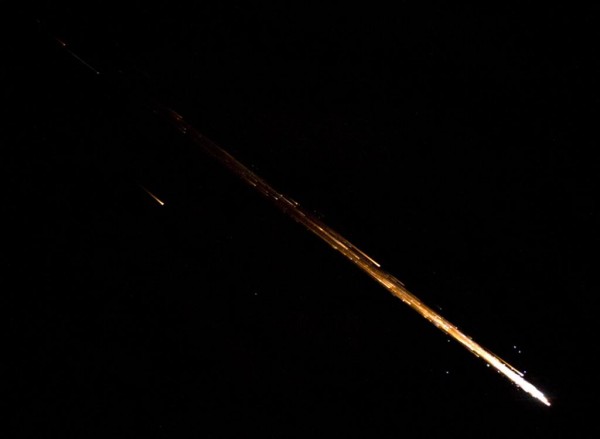Photos Capture Fiery Death Of American Spacecraft
| David Perry | | Aug 22, 2014 02:26 PM EDT |
(Photo : Alexander Gerst/ESA) A Cygnus vehicle fell to Earth in a blaze of light on August 17.
Engulfed in a brilliant shroud of flame, an unmanned spacecraft plunged to Earth in a scheduled descent and burn-up on August 17.
Aboard the International Space Station (ISS), European Space Agency (ESA) astronaut Alexander Gerst and his Russian cosmonaut peer Maxim Suraev snapped photos of the ethereal event over the Pacific Ocean east of New Zealand. The remote-controlled SS Janice Voss, a Cygnus space vehicle made by private American company Orbital Sciences Corporation, had delivered supplies to the ISS earlier this month as part of the Orb-2 mission.
Like Us on Facebook
The photos show pieces of the automated craft after it broke apart while shooting across the southern Pacific skies at 9:15 AM Eastern Daylight Time, according to Orbital Sciences representatives.
"From start to finish, we are very pleased with the results of this mission," Mr. Frank Culbertson, Executive Vice President and General Manager of Orbital's Advanced Programs Group said in a statement. "Our team is proud to be providing essential supplies to the ISS [International Space Station] crew so they can carry out their vital work in space."
The Orb-2 mission began on July 13 when Orbital's Antares-type rocket launched the SS Janice Voss Cygnus cargo ship into orbit from the Mid-Atlantic Regional Spaceport (called "MARS") located at NASA's Wallops Flight Facility in Eastern Virginia. The carft which carried 3,669 pounds of cargo and science payloads, berthed with the ISS three days later on July 16. Prior to its departure from the station, the astronauts loaded the cargo module with approximately 3,550 pounds of items for disposal.
The cargo vessel was named after American astronaut Janice Voss, who passed away from breast cancer at the age of 55 in 2012. The SS Janice Voss is the second of eight Cygnus freighters servicing the ISS. A controlled burn-up in the upper atmosphere is standard procedure for such vehicles.
TagsInternational Space Station, ISS, Orbital Sciences Corporation
©2015 Chinatopix All rights reserved. Do not reproduce without permission
EDITOR'S PICKS
-

Did the Trump administration just announce plans for a trade war with ‘hostile’ China and Russia?
-

US Senate passes Taiwan travel bill slammed by China
-

As Yan Sihong’s family grieves, here are other Chinese students who went missing abroad. Some have never been found
-

Beijing blasts Western critics who ‘smear China’ with the term sharp power
-

China Envoy Seeks to Defuse Tensions With U.S. as a Trade War Brews
-

Singapore's Deputy PM Provides Bitcoin Vote of Confidence Amid China's Blanket Bans
-

China warns investors over risks in overseas virtual currency trading
-

Chinese government most trustworthy: survey
-

Kashima Antlers On Course For Back-To-Back Titles
MOST POPULAR
LATEST NEWS
Zhou Yongkang: China's Former Security Chief Sentenced to Life in Prison

China's former Chief of the Ministry of Public Security, Zhou Yongkang, has been given a life sentence after he was found guilty of abusing his office, bribery and deliberately ... Full Article
TRENDING STORY

China Pork Prices Expected to Stabilize As The Supplies Recover

Elephone P9000 Smartphone is now on Sale on Amazon India

There's a Big Chance Cliffhangers Won't Still Be Resolved When Grey's Anatomy Season 13 Returns

Supreme Court Ruled on Samsung vs Apple Dispute for Patent Infringement

Microsoft Surface Pro 5 Rumors and Release Date: What is the Latest?










